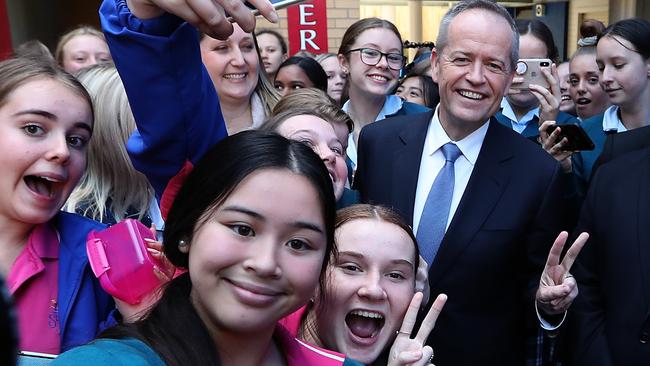Gender plan failed to assist women
Removing names from job applications to tackle gender bias backfired in a previous trial.

Removing names from public service job applications to tackle “unconscious” gender bias, a move championed by Bill Shorten yesterday, backfired in a previous trial, which found men benefited the most from the change.
The Opposition Leader yesterday talked up his record on addressing gender discrimination, at St Joseph’s Catholic College in the NSW central coast electorate of Robertson, where he was mobbed by schoolgirls in scenes reminiscent of Paul Keating’s 1996 encounter with students at Our Lady of Mercy College in Parramatta.
Mr Shorten predicted that, if Labor was elected, the caucus would comprise at least 49 per cent women. He listed gender-neutral resumes as a priority in the public service.
“You know when you write a job application … for the first round we’re not going to put someone’s name on the application … We’re just going to start eliminating what I call to be unconscious bias,” he said. “It’d be great to have a group of people from all sorts of backgrounds.”
Former Australian public service commissioner John Lloyd said blind recruitment was unnecessary, given women already held 59 per cent of jobs in the bureaucracy and representation at senior levels was increasing, while a trial involving 14 public service agencies in June 2017 found the system was ineffective.
The trial, commissioned by Malcolm Turnbull’s behavioural economics unit and overseen by a Harvard academic, found a woman’s likelihood of getting shortlisted fell by 2.9 per cent on average if her CV was de-identified, while the likelihood of a man being shortlisted for a job would increase by 3.2 per cent.
“The overall implications of our study are that, on average … introducing de-identification would have the unintended consequence of setting back efforts to promote more diversity at the senior management level in the public service,” the study authors said.
They said other methods to achieve equality should be investigated. “Other stages of recruitment could be tested, including how positions are advertised, what information is requested from applicants, how interviews are conducted, and how hiring panels are selected and run,” the authors said.
Mr Lloyd, who quit his commissioner’s role to join the right-wing Institute of Public Affairs, said the measure was being unnecessarily pushed by the unions.
“The public service has a much higher proportion of women than men in it … so there is no evidence of gender bias at all,” he said.
“Labor and the unions will bang on about this at every possible turn. But in the public service there (are) more women than men at most levels and the representation at senior executive levels is increasing every year.
“So I just don’t think there is evidence for it. In fact, you could see, in a few years coming, it might be a bit like school teaching, to make sure we don’t have too many women and not enough men.”
The public sector union backed the policy, which was also supported by the Liberal Party in a non-binding vote at its last federal council meeting.
Council of Small Business of Australia managing director Peter Strong said it would be a mistake for the edict to extend to the private sector.
Australian Chamber of Commerce and Industry chief executive James Pearson said human resource professionals were already aware of gender bias in recruitment practices.
“Many businesses, particularly larger businesses, have altered their recruitment practices to address bias,” Mr Pearson said. “To tackle this issue in a structured and effective way requires specialist human resource management skills which are normally only available in large businesses.”
Community and Public Sector Union national secretary Nadine Flood backed Mr Shorten’s policy, and declared governments should not be dissuaded by a single study.
“We’re really pleased that Labor is taking a nuanced and comprehensive plan on gender equality across the Australian economy to the election, rather than relying on any one solution to such an entrenched issue,” Ms Flood said. “Blind recruiting is certainly worth exploring, to establish whether previous doubts about its effectiveness reflect reality or ideology, as part of a package looking at all the barriers to gender equality.”
Ms Flood said there were major issues with women getting promotions to the senior levels of the public service. Women comprise 59 per cent of the public service but hold 43 per cent of positions at senior executive levels.
Representation at executive levels has increased from 36 per cent in 2008.
Additional reporting: Primrose Riordan



To join the conversation, please log in. Don't have an account? Register
Join the conversation, you are commenting as Logout